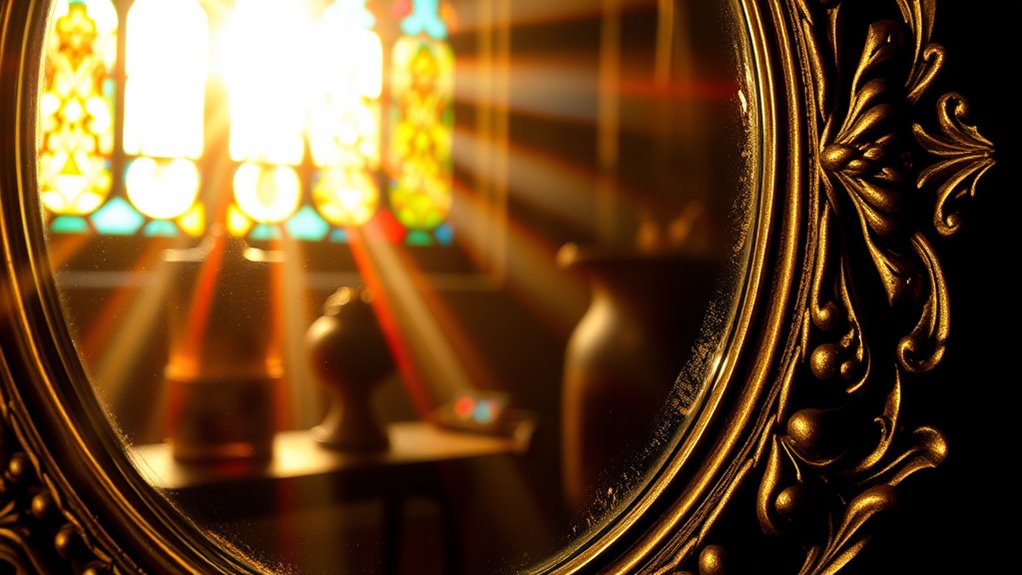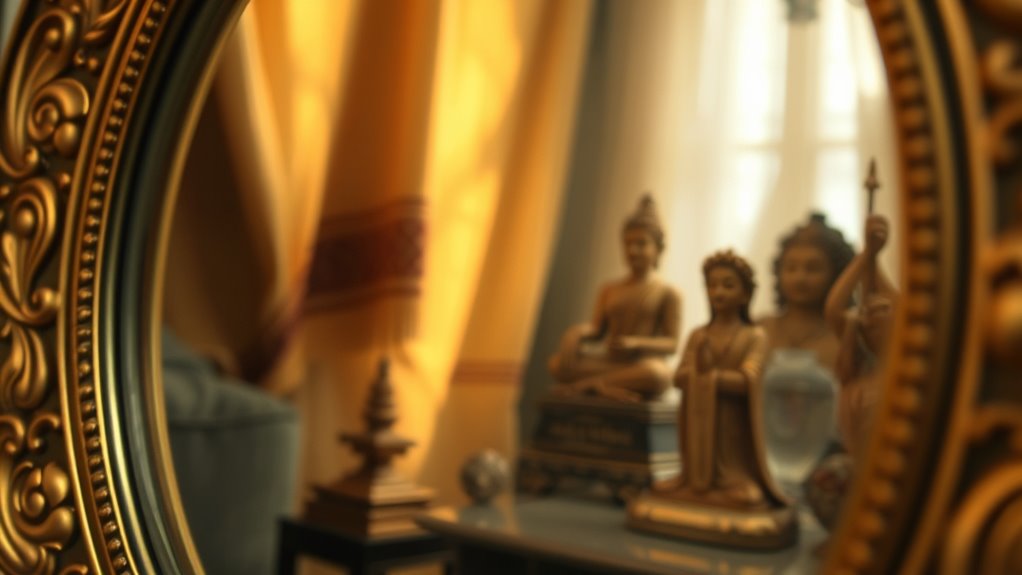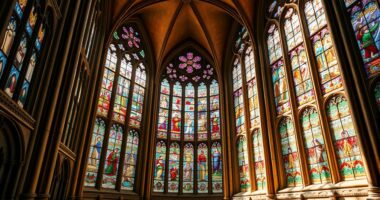In cultural narratives, mirrors and light symbolize self-awareness, inner truth, and transformation. When you look into a mirror, it challenges you to face your true self, often sparking growth and change. Light illuminates hidden aspects and guides you toward enlightenment. These symbols remind you that genuine understanding begins with honest reflection. Exploring how they appear in stories reveals deeper insights about identity and personal evolution—if you stay with it, you’ll uncover even more meaningful connections.
Key Takeaways
- Mirrors symbolize self-examination, inner truth, and identity transformation across diverse cultural stories.
- Light in narratives represents insight, enlightenment, and the pursuit of deeper self-awareness.
- Reflection prompts introspection, revealing hidden facets and fostering personal growth.
- Mirrors often mark rites of passage, emphasizing change, transition, and evolving identities.
- The interplay of mirror and light underscores the journey toward inner understanding and spiritual awakening.

Have you ever wondered how a simple mirror can reveal more than just your reflection? In countless cultural narratives, mirrors serve as powerful symbols that go beyond their practical use, embodying themes like identity transformation and illumination symbolism. When you gaze into a mirror, you’re not just seeing your physical appearance; you’re engaging in a process of self-examination that can lead to profound changes. The mirror acts as a catalyst for personal growth, offering a space where you confront your true self and consider who you are versus who you want to become. This act of reflection often signifies more than vanity—it becomes a mirror of your inner world, revealing hidden facets of your identity and sparking transformation.
Mirrors reveal inner truths and spark profound personal transformation through self-examination and reflection.
In many mythologies and stories, mirrors are seen as portals to enlightenment or truth. The illumination symbolism tied to mirrors suggests clarity, insight, and awakening. When you look into a mirror, it’s as if a light is shining inward, illuminating aspects of your character that might otherwise remain obscured. This symbolic illumination guides characters and individuals alike toward self-awareness, helping them recognize flaws, strengths, and possibilities. It’s no coincidence that in fairy tales and spiritual teachings, mirrors are often used to symbolize the path to enlightenment, where facing one’s reflection can lead to a revelation or a new understanding of oneself. Additionally, the reflection process can serve as a moment of introspection that fosters emotional and psychological growth.
Culturally, mirrors have also been used to signify a rite of passage, a point at which someone transitions from one identity to another. Think of stories where characters stare into a mirror and see a different version of themselves—an older, wiser self or a transformed being. These moments highlight the idea of identity transformation, where the act of reflection marks a turning point. The mirror becomes a symbol of change, emphasizing that growth often requires looking inward and questioning who you are.
You can see this concept play out across various traditions and stories, where the mirror’s role is not merely to reflect what’s on the outside but to reveal what’s within. The illumination symbolism attached to this act underscores the importance of self-awareness as a form of enlightenment. When you engage with a mirror in this way, you’re participating in a universal narrative—one that encourages you to look beyond surface appearances and seek deeper truths about yourself. It’s a reminder that transformation begins with honest reflection, and that sometimes, the light of understanding comes from facing your own reflection.
Frequently Asked Questions
How Do Cultural Narratives Influence Perceptions of Mirror Symbolism?
Cultural narratives shape how you perceive mirror symbolism by embedding mythological symbolism and cultural identity into your understanding. You might see mirrors as portals to self-discovery or reflection of societal values, depending on your background. These stories influence whether you view mirrors as symbols of truth, vanity, or spiritual insight. Your cultural context guides how you interpret mirror symbolism, connecting personal identity with mythological themes and collective beliefs.
What Role Does Light Play in Storytelling Beyond Visual Effects?
Light acts as a beacon of metaphorical illumination, guiding your understanding through storytelling’s depths. It symbolizes hope, truth, or enlightenment, turning scenes into powerful narrative symbolism. Beyond visual effects, light reveals characters’ inner struggles and moral clarity, like a lighthouse in a storm. Your journey through stories is illuminated by light’s subtle cues, shaping emotions and meaning, making every moment shine with deeper significance and insight.
Are There Universal Themes in Mirror and Light Symbolism Across Cultures?
You’ll find universal themes in mirror archetypes and light metaphors across cultures, reflecting the human desire for self-awareness and truth. Mirrors often symbolize self-discovery or deception, while light represents knowledge, purity, or enlightenment. These symbols transcend boundaries, suggesting that regardless of the culture, people seek clarity and understanding through reflections and illumination. Embracing these themes reveals shared human experiences rooted in the desire for insight and authenticity.
How Do Modern Media Reinterpret Traditional Mirror and Light Motifs?
Like a prism splitting light into colors, modern media reinterprets traditional mirror and light motifs to create fresh visual metaphors. You see this in films and social media, where mirrors symbolize self-awareness or deception, and light signifies truth or revelation. These reinterpretations prompt a perception shift, making audiences question appearances and deepen their understanding of identity. Media transforms old symbols into powerful tools for exploring human nature in new, compelling ways.
Can Reflections Reveal Subconscious Cultural Beliefs and Values?
Yes, reflections can reveal subconscious cultural beliefs and values. When you look into a mirror, you’re engaging in subconscious symbolism, often exposing deeper cultural truths about identity and societal standards. These reflections act as tools for cultural introspection, allowing you to see hidden biases, ideals, and stereotypes. By examining how reflections are portrayed and interpreted, you gain insight into the collective subconscious that shapes cultural narratives and influences individual perceptions.
Conclusion
So, next time you gaze into a mirror or bask in a beam of light, realize you’re witnessing the universe’s most epic stories—more captivating than any blockbuster. Your reflection holds secrets of ancient civilizations, and light reveals mysteries older than time itself. You’re not just seeing yourself; you’re peering into the heart of existence, where mirrors and light dance in an endless cosmic ballet. Embrace these moments—they’re more magical than you ever imagined!








